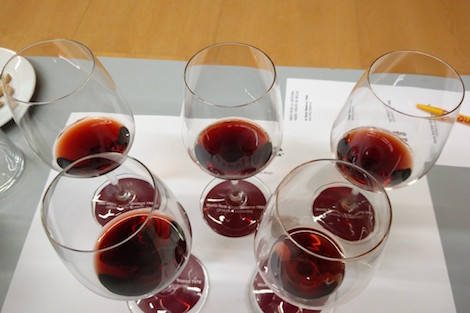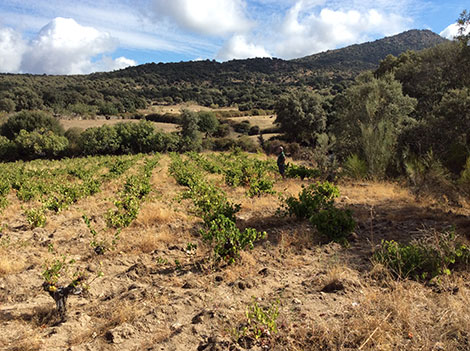Quinta da Muradella: the quiet search for wine purity
At first sight, A Canteira is one of those nondescript bars, with slot machines and a TV set where locals and workmen in blue overalls go for a coffee and a bit of conversation. But the difference between this bar in Verín in southern Galicia and a thousand other ones across Spain is that the everyday wine served here is made by José Luis Mateo, undoubtedly one of the most sensitive and honest winemakers in the Spanish scene.
We meet there, at his brother’s bar, before visiting some of the 20 hectares of vineyards he works (15ha of his own) in the Monterrei appellation, a region bordering Portugal with hot summers and freezing cold winters. Some of the 23 plots crown the highest lands of this Galician wine region, a remote and steep area which was abandoned by farmers some 30-40 years ago in search of higher yields and easier working conditions down by the valley.
“This is the drama in the Spanish countryside. Locals here used to earn their living cultivating chestnut trees and rearing cattle —there was even some smuggling”, explains José Luis as he calmly drives up the steep and narrow road toward his gorgeous vineyard in El Castrillón, at 700 meters of altitude.
There was a school, a surgery and other services for the community, he recalls, until they were all moved to urban areas in the name of so-called progress. “This area hides some amazing old vines but many of them have been abandoned. Those of us who continue working up here have to carry out maintenance works to avoid fires and keep paths free from vegetation; the authorities don’t seem to care much”, José Luis explains. He has used bed frames to build makeshift gates to keep wild boars and roe deers away from his grapes. In this unspoiled wilderness, wit is a necessary asset.
Being a winegrower was José Luis’s life calling. He moved to Madrid to study Journalism and Advertising but by the second year he knew it wasn’t his thing. His parents, people of modest means who had fought hard to get their son to study and prosper, asked him to finish his degree but his passion beat the family wishes to build his future away from the hardship they had known working the land.
A work of generations
He started Quinta da Muradella in 1991 with two plots where his father Alfonso, a mason by trade and farmer at heart, had grown grapes to make wine for the household and later for the A Canteira family bar. Slowly but surely, José Luis purchased more grapes and went on to make bulk and experimental wines until he launched Alanda Tinto in 2000, his first wine bearing a label.
“I used to make ripe wines, with structure, new oak and Mencía single varietals —it was a learning curve. I now make many blends and search for freshness; I want my wines to have good acidity and to convey the vineyard’s balance”, says José Luis.
In that constant pursuit of elegant, long-lasting balanced wines which express the different identities of the area, José Luis lets his grapes speak first, ahead of any marketing considerations. “This is a work of many generations. I’m not in a hurry; I’d rather do little, but be good at it”.
He vinifies his plots separately but he picks all the grape varieties within one plot at the same time; he adapts fermentations, aging methods and times to the characteristics of the vintage but the focus is always the same —to make fresh wines, something that is not easy given Monterrei’s climate. This attitude requires spending a lot of time in the vineyards doing manual work, but he is unfazed.
“I’m pretty anarchic in that respect; there are no clichés in wine. The only essential thing is that the vineyard has balance”, explains José Luis, who works organically since he launched Quinta da Muradella. The only vintage he was forced to use a systemic treatment was 2007, when mildew set in one of his Tempranillo plots and had to declassify it.
After the phylloxera epidemic in the region, grafted Garnacha Tintorera (Alicante Bouschet) and Mencía rootstocks were planted. José Luis advocates for genetic diversity so he works with numerous local grape varieties, some of them planted by himself with massal selections, such as Bastardo (Merenzao), Mencía, Garnacha Tintorera, Caíño Tinto, Albarello (Brancellao), Arauxa (Tempranillo), Sousón, Zamarrica and others which he is recovering.
In whites, he works with Treixadura, Godello, Dona Blanca and Monstruosa de Monterrei, among others. He is also testing clones and moving plants between different locations in his vineyards, located between 300 and 800 meters of altitude with various kinds of soils: clay, gravel, slate, quartz and granite.
He learnt a great deal from maverick winemaker Raúl Pérez, who helped him out in the early stages. “Working with Raúl was an extremely gratifying experience because he opened my mind. He taught me that the work in the vineyard and in the winery go hand in hand”, explains José Luis.
His creations echo both elements, but undoubtedly Quinta da Muradella wines ooze honesty and elegance, two traits that this humble and generous winegrower has in spades.
Heterogeneous portfolio
He makes a white and a red wine under the name Alanda (around €14 in Spain, from €22 € in Wine Searcher). They are, he says, his “presentation card”. Alanda red is a complex but accesible Mencía blended with Bastardo and other varieties. In 2012 he produced 8,000 bottles but he is unsure whether he will bottle any 2014 wine. “It was a challenging vintage. 2,500 liters from a vat went down the drain because I wasn’t happy with the quality”, he confesses. More than one producer would have been tempted to sell it under a different brand and priced competitively.
Given the number of varieties and styles he employs, Quinta da Muradella’s portfolio is wide and diverse with highly regarded single vineyard wines and blends such as Gorvia White and Red (around €22 in Spain, from €45 via Wine Searcher); Muradella Blanco and Tinto (€35 in Spain), Sábrego white (€23 in Spain, from €40 via Wine Searcher), Berrande (€36 in España) or experimental and brilliant bottlings such as Crianza Oxidativa 2009, a Dona Blanca single varietal made as a sherry, with a fine veil of yeast (from €24 in Spain)
or the 300 bottles of Monstruosa de Monterrei 2012 (€36), sourced from a vineyard planted in 2002 with this white variety under recovery. His fruity and expressive Garnacha Tintorera 2012, which he has recently bottled, will be marketed without an official label because DO Monterrei does not recognize this variety.
A great deal of his production is exported to countries such as the US or Australia, where he has a cult following and his wines command high prices. “I never imagined that my wines would be available in Australia; when I started, my dream was to make good wines and sell them across Galicia, but this is way more than I expected”, he says without a glimmer of false humility. “And the best thing is that I do just what I like”.

Yolanda Ortiz de Arri
A journalist with over 25 years' experience in national and international media. WSET3, wine educator and translator
NEWSLETTER
Join our community of Spanish wine lovers






